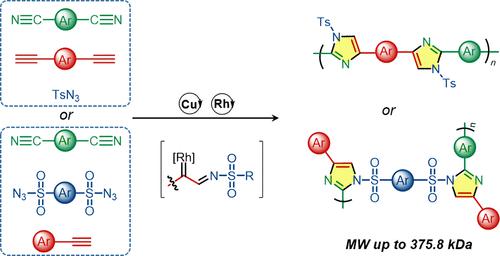当前位置:
X-MOL 学术
›
Macromolecules
›
论文详情
Our official English website, www.x-mol.net, welcomes your
feedback! (Note: you will need to create a separate account there.)
Multicomponent Synthesis of Imidazole-Based Cross-Conjugated Polymers via Bimetallic Cu(I)/Rh(II) Relay Catalysis
Macromolecules ( IF 5.1 ) Pub Date : 2022-06-23 , DOI: 10.1021/acs.macromol.2c01167 Ying Wang 1 , Zhen Zhang 1, 2
Macromolecules ( IF 5.1 ) Pub Date : 2022-06-23 , DOI: 10.1021/acs.macromol.2c01167 Ying Wang 1 , Zhen Zhang 1, 2
Affiliation

|
An efficient synthetic methodology for imidazole-based cross-conjugated polymers through bimetallic Cu(I)/Rh(II) relay-catalyzed multicomponent polymerization has been established. This polymerization employs readily available monomers, including aryl alkynes, azides, and aryl nitriles. Cu-catalyzed azide–alkyne cycloaddition (CuAAC) occurs first in this polymerization followed by the Rh-catalyzed ring-opening/transannulation of triazole intermediates. Various new imidazole-based cross-conjugated polymers with high molar mass (up to 375.8 kDa) have been prepared smoothly in high yields (83–98%). These polymers exhibit tunable optical properties and broad band gaps (Eg > 2.0 eV), featuring great application potential in organic electronic materials. This bimetallic relay-catalyzed multicomponent polymerization provides an alternative and highly efficient approach toward novel structural conjugated materials from simple building blocks via one-pot reactions.
中文翻译:

双金属Cu(I)/Rh(II)继电器催化咪唑基交叉共轭聚合物的多组分合成
建立了一种通过双金属 Cu(I)/Rh(II) 中继催化多组分聚合合成咪唑基交叉共轭聚合物的有效方法。这种聚合使用容易获得的单体,包括芳基炔烃、叠氮化物和芳基腈。Cu催化的叠氮化物-炔烃环加成(CuAAC)首先发生在该聚合中,然后是Rh催化的三唑中间体的开环/环环化。各种具有高摩尔质量(高达 375.8 kDa)的新型咪唑基交叉共轭聚合物已经以高产率(83-98%)顺利制备。这些聚合物表现出可调谐的光学特性和宽带隙(E g> 2.0 eV),在有机电子材料中具有巨大的应用潜力。这种双金属继电器催化的多组分聚合为从简单的结构单元通过一锅反应制备新型结构共轭材料提供了一种替代且高效的方法。
更新日期:2022-06-23
中文翻译:

双金属Cu(I)/Rh(II)继电器催化咪唑基交叉共轭聚合物的多组分合成
建立了一种通过双金属 Cu(I)/Rh(II) 中继催化多组分聚合合成咪唑基交叉共轭聚合物的有效方法。这种聚合使用容易获得的单体,包括芳基炔烃、叠氮化物和芳基腈。Cu催化的叠氮化物-炔烃环加成(CuAAC)首先发生在该聚合中,然后是Rh催化的三唑中间体的开环/环环化。各种具有高摩尔质量(高达 375.8 kDa)的新型咪唑基交叉共轭聚合物已经以高产率(83-98%)顺利制备。这些聚合物表现出可调谐的光学特性和宽带隙(E g> 2.0 eV),在有机电子材料中具有巨大的应用潜力。这种双金属继电器催化的多组分聚合为从简单的结构单元通过一锅反应制备新型结构共轭材料提供了一种替代且高效的方法。











































 京公网安备 11010802027423号
京公网安备 11010802027423号